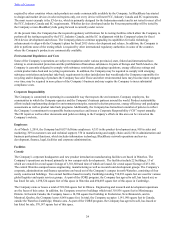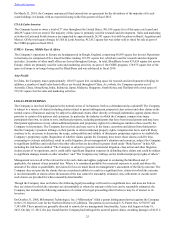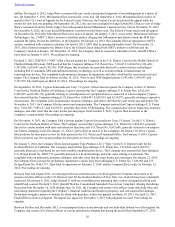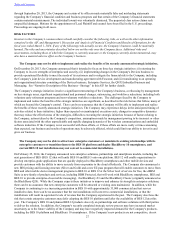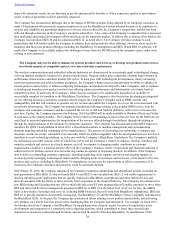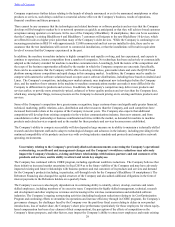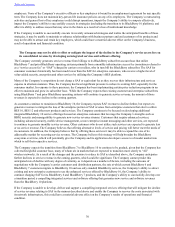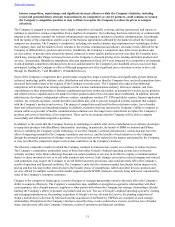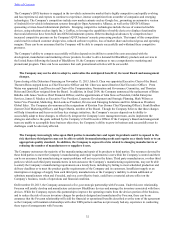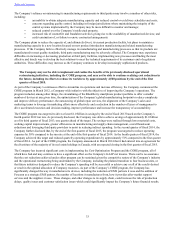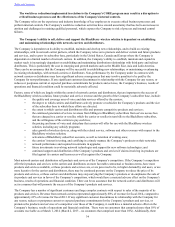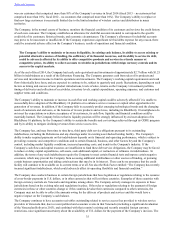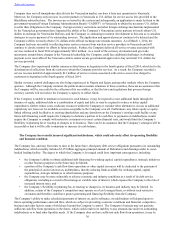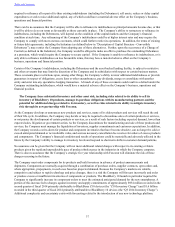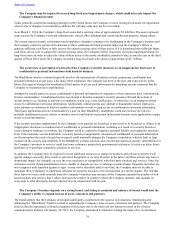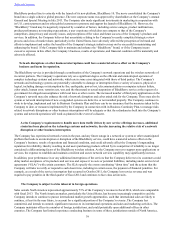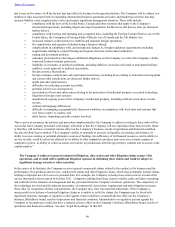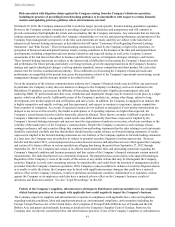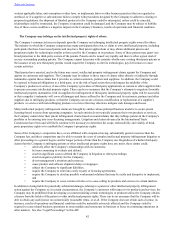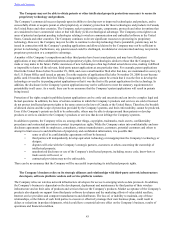Blackberry 2014 Annual Report Download - page 42
Download and view the complete annual report
Please find page 42 of the 2014 Blackberry annual report below. You can navigate through the pages in the report by either clicking on the pages listed below, or by using the keyword search tool below to find specific information within the annual report.
34
The workforce reductions implemented in relation to the Company's CORE program may result in a disruption to
critical business processes and the effectiveness of the Company's internal controls.
The Company relies on the experience and industry knowledge of key employees to execute critical business processes and
perform internal controls. The Company's workforce reduction activities have created uncertainty that has led to an increase in
attrition and challenges in retaining qualified personnel, which exposes the Company to risk of process and internal control
failures.
The Company’s ability to sell, deliver and support the BlackBerry wireless solution is dependent on establishing
and maintaining relationships with network carriers and distributors.
The Company is dependent on its ability to establish, maintain and develop new relationships, and to build on existing
relationships, with its network carrier partners, which the Company relies on to promote and deliver current and future products
and services, and to grow its subscriber base, particularly in the United States, Canada and Europe where the Company is
dependent on a limited number of network carriers. In addition, the Company’s ability to establish, maintain and expand its
market reach is increasingly dependent on establishing and maintaining distribution relationships with third party and indirect
distributors. This is particularly the case in emerging and growth markets such as the Middle East, Asia and Latin America.
There can be no assurance that the Company will be successful in establishing new relationships, or maintaining or enhancing
its existing relationships, with network carriers or distributors. Non-performance by the Company under its contracts with
network carriers or distributors may have significant adverse consequences that may involve penalties to be paid by the
Company for non-performance. If any significant customer discontinues its relationship with the Company for any reason, or
reduces or postpones current or expected purchase commitments for products and services, the Company’s business, results of
operations and financial condition could be materially adversely affected.
Factors, some of which are largely within the control of network carriers and distributors, that are important to the success of
the BlackBerry wireless solution, future product and service revenue and the growth of the Company’s subscriber base, include:
• the quality and coverage area of voice and data services offered by the carriers;
• the degree to which carriers and distributors actively promote or subsidize the Company’s products and the size
of the subscriber base to which these efforts are directed;
• the extent to which carriers and distributors offer and promote competitive products and services;
• the continued generation of service revenues from billings to BlackBerry subscribers from service access fees
that are charged to a carrier or reseller, which the carrier or reseller in turn bills to the BlackBerry subscriber,
and the willingness of the carriers to pay such fees;
• the pricing and terms of voice and data plans that carriers will offer for use with the BlackBerry wireless
solution, including any subsidy programs;
• sales growth of wireless devices, along with the related service, software and other revenues with respect to the
BlackBerry wireless solution;
• activations of BlackBerry subscriber accounts, as well as retention of existing ones;
• the carriers’ interest in testing, and certifying in a timely manner, the Company’s products on their networks;
• network performance and required investments in upgrades;
• future investments in evolving network technologies and support for new software technologies; and
• continued support and distribution of the Company’s products and services if claims involving its products are
filed against its carriers and licensees as well as against the Company.
Most network carriers and distributors sell products and services of the Company’s competitors. If the Company’s competitors
offer their products and services to the carriers and distributors on more favorable contractual or business terms, have more
products and services available, or those products and services are, or are perceived to be, in higher demand by end users, or are
more lucrative for the carriers and distributors, there may be continued pressure on the Company to reduce the price of its
products and services, or those carriers and distributors may stop carrying the Company’s products or de-emphasize the sale of
its products and services in favor of the Company’s competitors, which would have a material adverse effect on the Company’s
business, results of operations and financial condition. There can be no assurance that the network carriers and distributors will
act in a manner that will promote the success of the Company’s products and services.
The Company has a number of significant customers and large complex contracts with respect to sales of the majority of its
products and services. Revenue from network carriers represented approximately 60% of revenue for fiscal 2014, compared to
approximately 63% of revenue for fiscal 2013. If any significant customer discontinues its relationship with the Company for
any reason, reduces or postpones current or expected purchase commitments for the Company’s products and services, or
promotes the products and services of a competitor over those of the Company, it could have a material adverse effect on the
Company’s business, results of operations and financial condition. There were no customers that comprised more than 10% of
accounts receivable as at March 1, 2014 (March 2, 2013 – no customers that comprised more than 10%). Additionally, there
Table of Contents


